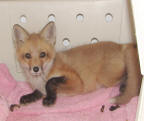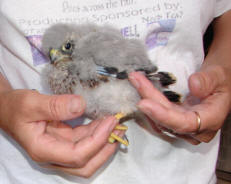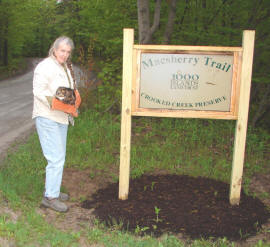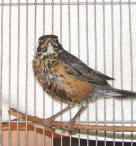WELLESLEY ISLAND WILDLIFE REHABILITATION
Click HERE if you need help with an injured or orphaned animal
Click HERE if you need help with an injured or orphaned animal
 Our wildlife rehab practice began when Sue-Ryn and Steve went to hear a wildlife rehabilitator speak at Macsherry Library, in Alex Bay--they are
both trustees of that library. Afterward zookeeper and evil friend Sue
Sabik and the woman who gave the talk, Jackie C, both tried to convince
Sue-Ryn that she could do wildlife rehab. Dangerously supportive husband
Steve assured her that he would help her if that was what she wanted to
do.
Our wildlife rehab practice began when Sue-Ryn and Steve went to hear a wildlife rehabilitator speak at Macsherry Library, in Alex Bay--they are
both trustees of that library. Afterward zookeeper and evil friend Sue
Sabik and the woman who gave the talk, Jackie C, both tried to convince
Sue-Ryn that she could do wildlife rehab. Dangerously supportive husband
Steve assured her that he would help her if that was what she wanted to
do. But a bit of everything passes through Wellesley Island Wildlife. The
year 2011 brought several batches of starlings, chipping sparrows,
3
young orphaned crows, 3 young great horned owls, cottontail
bunnies, a snowshoe rabbit, red, gray and black squirrels, three or
four batches of baby kestrels, baby merlins, fledgling kestrels and
merlins, over a dozen robins, an oriole, a cardinal, wrens, woodpeckers,
bank swallows, song sparrows, 3 pigeons, assorted grackles, blue jays, a
kingfisher, and of late, a gimpy domestic duck living in our pond.
But a bit of everything passes through Wellesley Island Wildlife. The
year 2011 brought several batches of starlings, chipping sparrows,
3
young orphaned crows, 3 young great horned owls, cottontail
bunnies, a snowshoe rabbit, red, gray and black squirrels, three or
four batches of baby kestrels, baby merlins, fledgling kestrels and
merlins, over a dozen robins, an oriole, a cardinal, wrens, woodpeckers,
bank swallows, song sparrows, 3 pigeons, assorted grackles, blue jays, a
kingfisher, and of late, a gimpy domestic duck living in our pond. The
goal of wildlife rehabilitation is to rehabilitate injured and orphaned
animals and return them to the wild. Baby birds and mammals are
fed and housed, trained to self-feed, and then released in a place where
they have the best chance of surviving and thriving. We have had
former patients return the next year, check in, and then move on off to
their lives. The animals are not like those in a zoo, here human
interaction is kept at a low level so that the animals do not imprint
too deeply on those caring for them. Not all animals can be released
into the wild; some instead go on to live at educational facilities, or
in species-specific sanctuaries. The picture at left is of the great
horned owl we accepted Christmas eve, 2010, being released this spring.
The
goal of wildlife rehabilitation is to rehabilitate injured and orphaned
animals and return them to the wild. Baby birds and mammals are
fed and housed, trained to self-feed, and then released in a place where
they have the best chance of surviving and thriving. We have had
former patients return the next year, check in, and then move on off to
their lives. The animals are not like those in a zoo, here human
interaction is kept at a low level so that the animals do not imprint
too deeply on those caring for them. Not all animals can be released
into the wild; some instead go on to live at educational facilities, or
in species-specific sanctuaries. The picture at left is of the great
horned owl we accepted Christmas eve, 2010, being released this spring.To read an article in Thousand Island Life about Sue-Ryn and Wellesley Island Wildlife Rehabilitation click here.
The State does not in any way help support this work. Donations, yard sales, and various other fund-raising efforts help keep us functioning. Donated medical supplies and veterinary services are crucial to rehab. To deal with what comes in here are just a few of the things we have to keep in stock: three different kinds of animal milk replacer; mealworms, fishworms, dried insects, dry mix baby bird formula, and specific kinds of cat food and other ingredients for home-brew baby bird formula; various vitamins, minerals, and nutritional supplements; wild game chow; rodent block; raw burger and frozen mice; various fruits, vegetables, nuts, seeds and grains; pedialite, antiseptics, topical antibiotics, bandages, and pharmaceuticals; dozens upon dozens of different sized feeding bowls and trays, waterers, feeding syringes and brushes; tubs, aquariums and indoor cages of different sizes; heating pads and warming lamps; piles of towels and sheets and cleaning cloths; bigger outdoor cages--we have three flight cages, and more small cages for outdoor housing or time outside in the daylight. Animal carriers in every shape and size.
What we mostly do is get food into one end of our patients and clean up the poop that comes out the other end. A lot of poop, some of it ending up on us. Rehab generates more dirty dishes and dirty laundry than our regular lives. We even need a second fridge to keep different bird and mammal formulas, along with extra fruit and meat.
Wildlife rehab demands a considerable commitment in money and time. All the foods, meds, caging materials, electric for heat and light, and endless loads of dishes and laundry. Picking up and transferring animals takes a lot of gas, even with our little 25 MPG Escape.
Feeding begins first thing in the morning and goes on late into the evening. Nestling birds have to be fed once an hour at first, then ease back to somewhat longer intervals. Small mammals have to be nursed, and in some cases stimulated so they can pee and poop, a task that the mother would normally perform. Caging is always being built, modified, lugged around, and of course cleaned. Increased laundry, heating the rehab space, and running a second refrigerator runs up our electric bills.
Wildlife rehab is demanding, and can be heartbreaking because not everything survives, but most of all it is tremendously rewarding.
We have looked into getting not for profit status, but that is a slow, complicated, and worst of all, expensive process. Sue-Ryn decided that any money we do have would be better spent serving the animals. So donations can't be written off.
If you would like to donate money to help, please do so as a 'gift' to Sue-Ryn. That money goes into a separate account used only for rehab expenses.
There are other ways to help out; here's a wish list:
>Donate useable, interesting goods for the yard sales we run periodically as fundraisers.
>Gift cards or certificates to Wellesley Island Builders, Agway, and Petco.
>Sunoco gas cards are useful, too. It's close to a 60 mile trip to the Vet in Watertown and back, around 90 miles to do an animal trade-off in Pulaski, double that if we take the animal all the way to Kindred Kingdoms in Pennellville. Then there are the trips to pick up and release wildlife; these can be trips to Clayton, Chaumont, Gouverneur, Theresa, Point Peninsula, Watertown. We're always filling the tank--again.
>Gift certificates to Chris's Squirrels & More or New York Worms.
>Large plastic storage bins-with or without lids--are always handy.
>We could use a couple more large animal carriers. Gently used aquariums.
>A dog kennel, or chain link fencing. Surplus building materials such as 2x4s, plywood.
>A baby monitor.
>Heating pads that don't turn off automatically.
>An incubator.
 Future
and ongoing projects include: building outdoor caging for raptors and
other birds; installing heat in our expanded rehab room; a minnow
tank for shorebird food
Future
and ongoing projects include: building outdoor caging for raptors and
other birds; installing heat in our expanded rehab room; a minnow
tank for shorebird foodIf you have any questions about helping out, give us a call at [315] 482-2985.